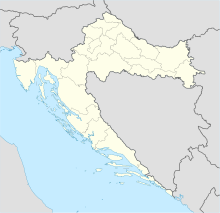Pasjača Beach
This article is written like a travel guide rather than an encyclopedic description of the subject. (December 2020) |
| Pasjača Beach | |
|---|---|
 Pasjača Beach viewed from the cliff | |
 | |
| Location | Konavle, Croatia |
| Coordinates | 42°30′48″N 18°19′14″E / 42.5134°N 18.3206°ECoordinates: 42°30′48″N 18°19′14″E / 42.5134°N 18.3206°E |
| Offshore water bodies | Adriatic Sea |
| Length | 80 meters |
| Width | 10 meters |
| sand, gravel | |
Pasjača Beach ['pʌsɪ̯ʌʧʌ] is a small, hidden sand and gravel beach in Konavle region, southern Croatia.[1] It is situated below the Konavle cliffs where it meets the Adriatic Sea forming a narrow sandy-gravelly coastal strip of unique and wonderful beauty.
Location[]
Pasjača is located approximately 30 kilometres far from Dubrovnik,[2] one of the most prominent and most visited tourist destinations in the Mediterranean Sea, a seaport and the centre of Dubrovnik-Neretva County. Cavtat, the seat of Konavle, is about 12 km away. There is an asphalted road from Cavtat to , a village close to the beach, as well as a parking space for up to 50 cars. A narrow path then leads steeply downwards from the cliffs to the beach.
Features[]
The beach is small, narrow, mostly sandy and gravelly, with some rocks in the shallow sea. It is approximately 80 meters long and 10 meters wide on the average. The turquoise sea water is limpid and crystal clear. Remote and difficult to access, Pasjača is a paradise[3] for nature lovers, hikers and adventurers and less appropriate for elderly or disabled people and families with small children.
There are no beach facilities or any structures on Pasjača (toilet, kiosk, market stall, shower, changing stall etc.) and therefore guests have to take everything (food, drink, deckchairs...) with them or prepare for Robinson tourism.
History[]
Pasjača was formed in the middle of the 20th century. When building a tunnel, the excavated stone material was thrown into the sea from the edge of the 200-meter-high cliff. In only a few years, the waves of the Adriatic Sea transformed the stones into a beach filled with fine sand. As the sea water later slowly carried the sand away, the stone material was replaced and the aesthetic was preserved.
See also[]
References[]
- ^ "Pasjača Beach". Croatian National Tourist Board. Retrieved 26 December 2020.
- ^ "Breathtaking Pasjača – the best beach in Europe". The Dubrovnik Times. Retrieved 26 December 2020.
- ^ "Pasjača Beach in Dubrovnik, a MUST DO in Croatia". Finding New Paths. Retrieved 26 December 2020.
Gallery[]
Konavle cliffs with Pasjača in the background

Aerial view

Parking space

View from the narrow path leading downwards
- Beaches of Croatia
- Konavle
- Landforms of Dubrovnik-Neretva County
- Tourist attractions in Dubrovnik-Neretva County




